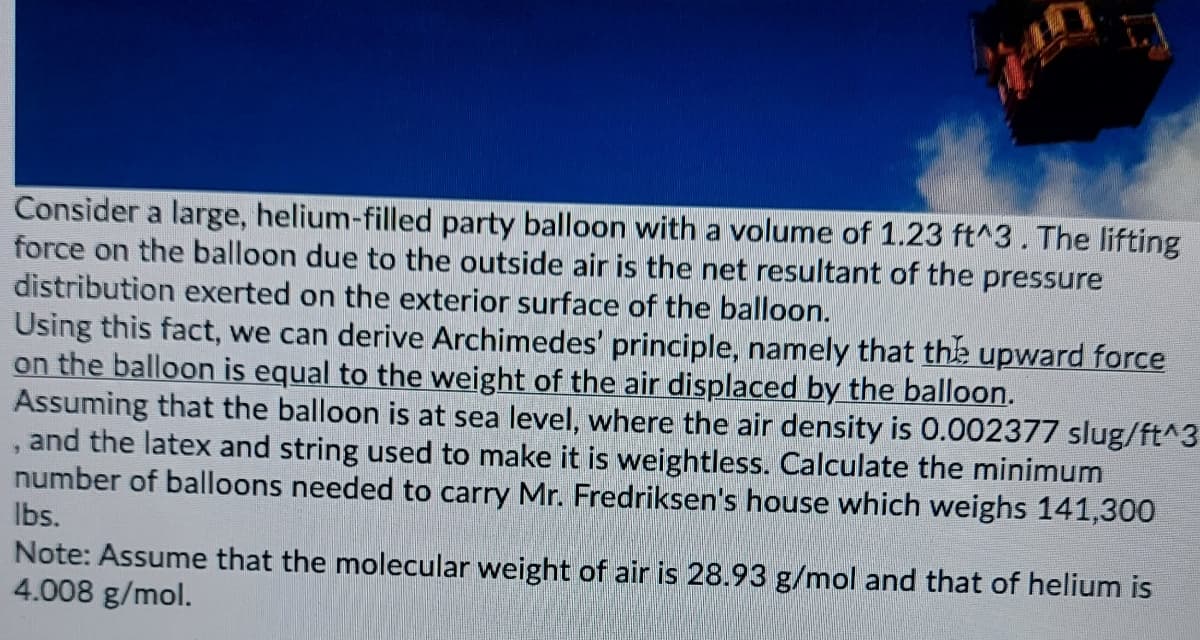Consider a large, helium-filled party balloon with a volume of 1.23 ft^3. The lifting force on the balloon due to the outside air is the net resultant of the pressure distribution exerted on the exterior surface of the balloon. Using this fact, we can derive Archimedes' principle, namely that the upward force on the balloon is equal to the weight of the air displaced by the balloon. Assuming that the balloon is at sea level, where the air density is 0.002377 slug/ft^3 , and the latex and string used to make it is weightless. Calculate the minimum number of balloons needed to carry Mr. Fredriksen's house which weighs 141,300 Ibs. Note: Assume that the molecular weight of air is 28.93 g/mol and that of helium is 4.008 g/mol.
Consider a large, helium-filled party balloon with a volume of 1.23 ft^3. The lifting force on the balloon due to the outside air is the net resultant of the pressure distribution exerted on the exterior surface of the balloon. Using this fact, we can derive Archimedes' principle, namely that the upward force on the balloon is equal to the weight of the air displaced by the balloon. Assuming that the balloon is at sea level, where the air density is 0.002377 slug/ft^3 , and the latex and string used to make it is weightless. Calculate the minimum number of balloons needed to carry Mr. Fredriksen's house which weighs 141,300 Ibs. Note: Assume that the molecular weight of air is 28.93 g/mol and that of helium is 4.008 g/mol.
Elements Of Electromagnetics
7th Edition
ISBN:9780190698614
Author:Sadiku, Matthew N. O.
Publisher:Sadiku, Matthew N. O.
ChapterMA: Math Assessment
Section: Chapter Questions
Problem 1.1MA
Related questions
Question
100%
Need asap answer

Transcribed Image Text:Consider a large, helium-filled party balloon with a volume of 1.23 ft^3. The lifting
force on the balloon due to the outside air is the net resultant of the pressure
distribution exerted on the exterior surface of the balloon.
Using this fact, we can derive Archimedes' principle, namely that the upward force
on the balloon is equal to the weight of the air displaced by the balloon.
Assuming that the balloon is at sea level, where the air density is 0.002377 slug/ft^3
, and the latex and string used to make it is weightless. Calculate the minimum
number of balloons needed to carry Mr. Fredriksen's house which weighs 141,300
Ibs.
Note: Assume that the molecular weight of air is 28.93 g/mol and that of helium is
4.008 g/mol.
Expert Solution
This question has been solved!
Explore an expertly crafted, step-by-step solution for a thorough understanding of key concepts.
This is a popular solution!
Trending now
This is a popular solution!
Step by step
Solved in 3 steps with 3 images

Recommended textbooks for you

Elements Of Electromagnetics
Mechanical Engineering
ISBN:
9780190698614
Author:
Sadiku, Matthew N. O.
Publisher:
Oxford University Press

Mechanics of Materials (10th Edition)
Mechanical Engineering
ISBN:
9780134319650
Author:
Russell C. Hibbeler
Publisher:
PEARSON

Thermodynamics: An Engineering Approach
Mechanical Engineering
ISBN:
9781259822674
Author:
Yunus A. Cengel Dr., Michael A. Boles
Publisher:
McGraw-Hill Education

Elements Of Electromagnetics
Mechanical Engineering
ISBN:
9780190698614
Author:
Sadiku, Matthew N. O.
Publisher:
Oxford University Press

Mechanics of Materials (10th Edition)
Mechanical Engineering
ISBN:
9780134319650
Author:
Russell C. Hibbeler
Publisher:
PEARSON

Thermodynamics: An Engineering Approach
Mechanical Engineering
ISBN:
9781259822674
Author:
Yunus A. Cengel Dr., Michael A. Boles
Publisher:
McGraw-Hill Education

Control Systems Engineering
Mechanical Engineering
ISBN:
9781118170519
Author:
Norman S. Nise
Publisher:
WILEY

Mechanics of Materials (MindTap Course List)
Mechanical Engineering
ISBN:
9781337093347
Author:
Barry J. Goodno, James M. Gere
Publisher:
Cengage Learning

Engineering Mechanics: Statics
Mechanical Engineering
ISBN:
9781118807330
Author:
James L. Meriam, L. G. Kraige, J. N. Bolton
Publisher:
WILEY